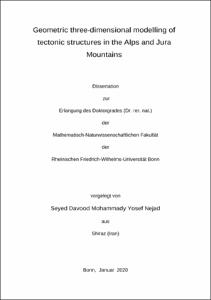Geometric three-dimensional modelling of tectonic structures in the Alps and Jura Mountains

Geometric three-dimensional modelling of tectonic structures in the Alps and Jura Mountains

| dc.contributor.advisor | Froitzheim, Nikolaus | |
| dc.contributor.author | Mohammady Yosef Nejad, Seyed Davood | |
| dc.date.accessioned | 2021-06-01T14:49:46Z | |
| dc.date.available | 2021-06-01T14:49:46Z | |
| dc.date.issued | 01.06.2021 | |
| dc.identifier.uri | https://hdl.handle.net/20.500.11811/9117 | |
| dc.description.abstract | Geometric and kinematic three-dimensional (3D) modelling of complex geological structures experienced an outstanding evolution and has become more and more important nowadays in the field of geoscience as well as oil and gas industry both for research and engineering purposes. Modelling of the geoscience data in 3D format is not only for visualizing the data but also a powerful tool to combine all the surface and subsurface geological data in one environment in order to evaluate complex geological structures and to test different theories for structural geologists, geophysicists and petroleum engineers.
The Jura Mountains and the Eastern part of the Alps are very well studied. However, despite the availability of a large amount of data (geological maps, profiles, seismic data etc.) that have been produced in the last three decades, many issues related to the subsurface structures, subduction of continental crust, structural history as well as collisional and post-collisional processes remain unknown and matter of debate between different scientists. The long-term goal of this thesis is to integrate all available data together, build a valid geometric and (partly) kinematic three dimensional model, visualize the data in a 3D environment and finally test different hypothesis and ideas by using suitable geoscience software (MOVE from Midland Valley Corporation). For this purpose, I have built two geometric 3D models, first for a small-scale area (Val de Ruz area in the Jura Mountains) and then for a large-scale area (Eastern part of the Alps). After that I have tried to answer specific and open questions regarding these areas and test whether or not the simulation software could help us for understanding the complex subsurface structures and finding the answers to the unsolved problems. The results of the 3D model for the Val de Ruz area show significant pre-thrusting thickness variations for the Muschelkalk unit. The variation is at least partly due to lateral flow of the Triassic evaporites during the early phase of detachment folding, away from synclines and towards anticlines. Assuming a second decoupling horizon in the Dogger or involvement of the basement in the Jura tectonics is unnecessary for explaining the geology of the study area. For the Eastern Alps, the added shortening of European and South Alpine basements is at a maximum at the western end of the Tauern Window, probably reflecting pre-Alpine margin geometry (Dolomites indenter). By the shortening calculations I have also estimate the area that is missing due to the collision during the Alpine orogeny which is the area that was destructed by the movement of Adria towards Europe since 30 Ma. The data also shows the average tectonic velocity between 3 to 6 mm per year which is in a good range compared to other available data. In addition to that, the modelling and quantitative calculations show that, about 59% and 25% of the current crust volume from the European and Adriatic continents respectively, have been destructed as a result of collision since 30 Ma. The results extracted from the 3D model and also from the calculations lead to the conclusion that about 812 997 km^3 of the continental crust from the eastern part of the Alps were subducted into the mantle since 30 Ma. From this total destructed volume about 82% belonged to the European continent and 18% to the Adriatic continent and this amount of subducted crust could represent the minimum amount of material for this part of the Alps. To conclude, three dimensional models which were tested for the Val de Ruz area and the Eastern part of the Alps, allowed us to integrate a large amount of data, plot them in one environment, gain insight into the complex tectonic structures and finally helped us to tackle some issues for these two areas. These 3D models for both of these areas provide valuable and comprehensive data files that could be used later as an input data for further research and investigation. | en |
| dc.language.iso | eng | |
| dc.rights | In Copyright | |
| dc.rights.uri | http://rightsstatements.org/vocab/InC/1.0/ | |
| dc.subject | 3D subsurface modelling | |
| dc.subject | Jura Mountains | |
| dc.subject | Alps | |
| dc.subject.ddc | 550 Geowissenschaften | |
| dc.title | Geometric three-dimensional modelling of tectonic structures in the Alps and Jura Mountains | |
| dc.type | Dissertation oder Habilitation | |
| dc.publisher.name | Universitäts- und Landesbibliothek Bonn | |
| dc.publisher.location | Bonn | |
| dc.rights.accessRights | openAccess | |
| dc.identifier.urn | https://nbn-resolving.org/urn:nbn:de:hbz:5-61968 | |
| ulbbn.pubtype | Erstveröffentlichung | |
| ulbbnediss.affiliation.name | Rheinische Friedrich-Wilhelms-Universität Bonn | |
| ulbbnediss.affiliation.location | Bonn | |
| ulbbnediss.thesis.level | Dissertation | |
| ulbbnediss.dissID | 6196 | |
| ulbbnediss.date.accepted | 29.05.2020 | |
| ulbbnediss.institute | Mathematisch-Naturwissenschaftliche Fakultät : Fachgruppe Erdwissenschaften / Institut für Geowissenschaften | |
| ulbbnediss.fakultaet | Mathematisch-Naturwissenschaftliche Fakultät | |
| dc.contributor.coReferee | Nagel, Thorsten J. |
Dateien zu dieser Ressource
Das Dokument erscheint in:
-
E-Dissertationen (4387)




